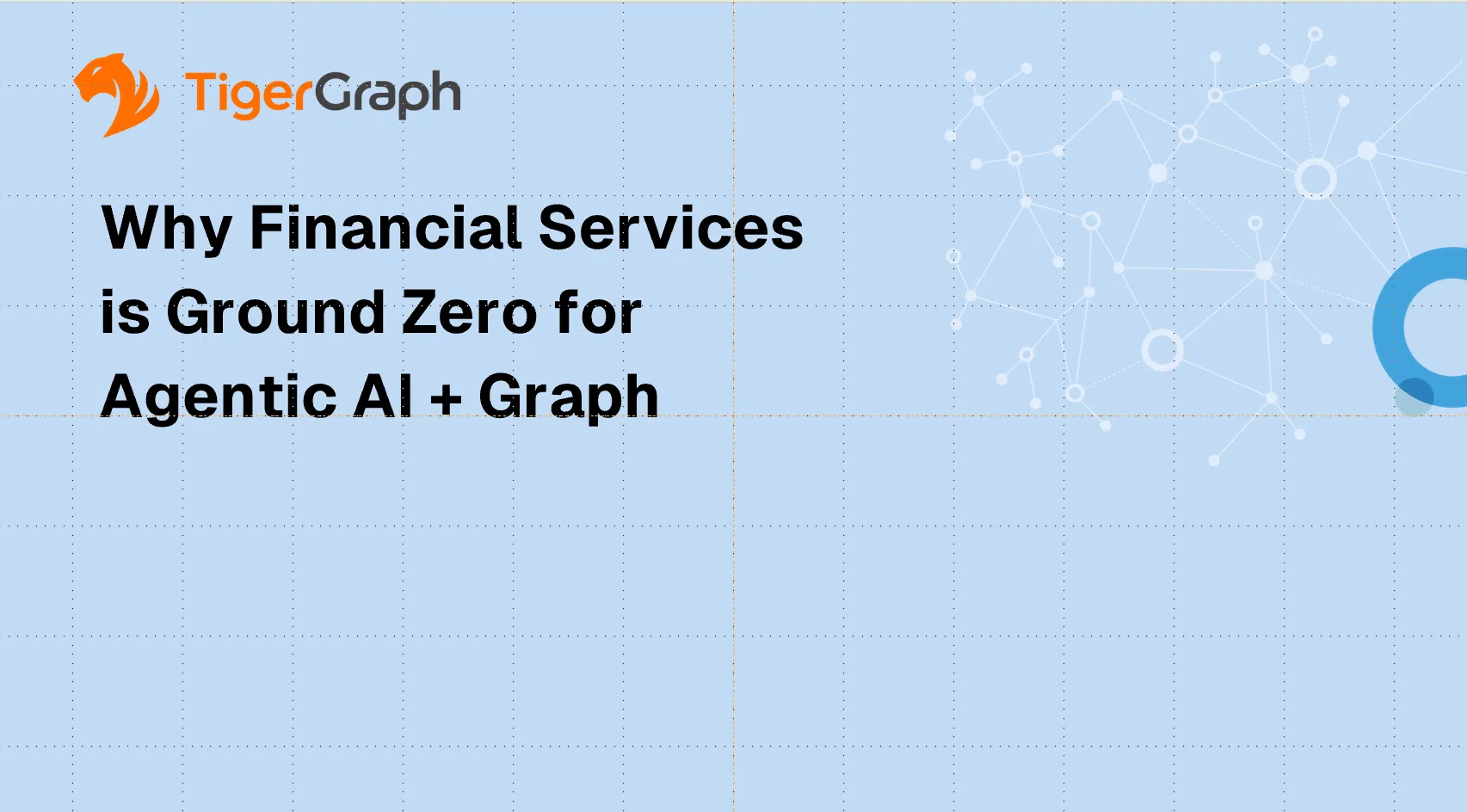Why Financial Services Is Ground Zero for Agentic AI + Graph
Financial services is fundamentally an industry of relationships. Every transaction, account, merchant, regulator, and risk event is interconnected—part of a larger web of interactions that influence financial behavior and decision-making.
The problem? Most traditional data systems don’t capture this complexity. They flatten rich, dynamic relationships into static tables—rows and columns that make it difficult to understand how entities are connected or how patterns unfold over time. This limits the system’s ability to adapt, detect anomalies, or respond to emerging threats.
In today’s financial environment, that’s no longer acceptable. Institutions are facing:
- More sophisticated fraud schemes that blend small signals across accounts and time.
- Higher expectations for real-time personalization, from customers who want relevant, timely experiences.
- Mounting regulatory pressure to ensure transparency, traceability, and compliance across increasingly complex operations.
To meet these demands, financial institutions need systems that do more than crunch numbers—they need systems that understand context, explain decisions, and adapt as conditions change. This is exactly where the combination of Agentic AI and graph technology excels.
Agentic AI brings autonomous reasoning and action. Graph databases provide structured knowledge and real-time connectivity. Together, they form a powerful foundation for intelligent, adaptive, and transparent financial systems—built not just to react, but to understand and evolve.
Financial Services Needs More Than Traditional AI
Legacy AI systems in finance often resemble advanced calculators—programmed to take in inputs, run models, and return outputs. While useful, they’re inherently limited: They rely on static data and predefined rules and lack the ability to adapt when conditions shift.
But the financial landscape is anything but static. Fraud patterns morph daily, regulatory mandates evolve, and customer behavior is influenced by everything from economic trends to real-time events. Static AI struggles to keep pace in a world that is becoming less predictable.
This is where Agentic AI comes in. Unlike traditional models, Agentic AI systems are designed to act like agents—they plan, reason through multiple possibilities, execute actions, and learn from outcomes to improve over time. They aren’t just reactive; they operate continuously, adapting as new information becomes available.
However, autonomy comes with risk. For AI to act responsibly—especially in regulated industries like finance—it needs more than just data. It needs structured, connected context that helps it understand not only what is happening, but why. That’s the role of graph databases.
Graphs provide the connective tissue: a flexible way to represent how people, accounts, transactions, and behaviors relate over time. Graph gives AI context and causality; it’s what lets agents reason and act responsibly.
In short, if Agentic AI is the brain, the graph is the knowledge base—and in finance, you can’t have responsible AI without brains and knowledge!
Graph as The Context Engine for Financial Intelligence
Financial crime doesn’t emerge from a single point of failure—it develops through patterns of behavior over time. A suspicious login. A series of low-value transfers. An account linked to a shell entity. On their own, these signals might appear benign. But together, they form a network of risk.
Detecting that network requires more than data—it requires understanding how that data connects. That’s where graph technology comes in.
Unlike traditional databases that store data in rigid tables, a graph database models the relationships between data points as first-class citizens. Nodes represent entities like users, accounts, or transactions. Edges represent how those entities are connected—by ownership, behavior, timing, or geography. This structure enables systems to ask better questions and find complex patterns that would be hidden in a traditional schema.
TigerGraph takes this even further. It’s a distributed, high-performance graph platform designed specifically for deep, real-time relationship analytics at scale. That means Agentic AI systems powered by TigerGraph can:
- Follow multi-step chains of relationships across vast financial networks in milliseconds.
- Surface early warning signs by connecting subtle signals into recognizable threat patterns.
- Learn and adapt as new behaviors emerge—without retraining from scratch.
Other technologies can’t keep up.
Relational databases struggle with multi-hop queries and can’t efficiently represent dynamic relationships. Modeling complex connections across accounts, entities, or behaviors becomes inefficient as query depth grows.
Even other graph systems face limitations with features that are essential for advanced use cases like real-time fraud detection, regulatory compliance, and explainable AI. TigerGraph’s native parallel architecture and expressive query language (GSQL) were specifically designed to support these workloads at enterprise scale.
TigerGraph gives Agentic AI not just access to data, but a rich, structured context. That’s how financial institutions move from reactive to proactive—understanding not just what’s happening, but why, and what to do next.
Agentic AI + TigerGraph in Action
Agentic AI becomes truly powerful when paired with a data infrastructure that understands relationships. That’s where TigerGraph comes in—enabling AI agents to reason over complex patterns, adapt in real-time, and confidently explain their decisions. This fusion delivers value across critical domains in financial services, from fraud prevention to regulatory compliance. Here’s how:
- Anti-Money Laundering (AML)
TigerGraph models suspicious behavior across shell accounts, offshore links, and timing anomalies. Agentic AI agents use this rich graph context to flag emerging risks and kick off proactive investigations—before a suspicious activity report (SAR) is even filed. - Fraud Detection at Scale
From login anomalies to test transactions, TigerGraph connects the dots. Agentic AI reasons over these signals in real-time: “Have we seen this before?” “Is this user linked to other flagged entities?” “What if this pattern continues?” - Credit and Risk Intelligence
Beyond static credit scores, TigerGraph enables dynamic assessments based on relationship networks, transaction behaviors, and anomalies. AI can evaluate risk in context—per user, event, or trend. - Compliance and Explainability
Decisions must be transparent in highly regulated environments. TigerGraph’s knowledge graph acts as policy infrastructure and audit trail, enabling AI to explain decisions and comply with frameworks.
The Future of Finance Is Built on Relationships
Modern financial challenges are rooted in complexity, not just volume. They demand more than fast responses—they require systems that understand the why behind the what, connect context, take action, and explain every step along the way.
Agentic AI enables adaptive decision-making. Graph provides the structural intelligence to ground that reasoning. TigerGraph unites them—delivering real-time, scalable, explainable AI that financial institutions can trust.
In a world where trust is earned by transparency and agility, we give financial leaders the tools to see deeper, act faster, and stay ahead. The future of finance is not just graph-powered, it’s graph-intelligent. Reach out to learn more about building this intelligent understanding together.

